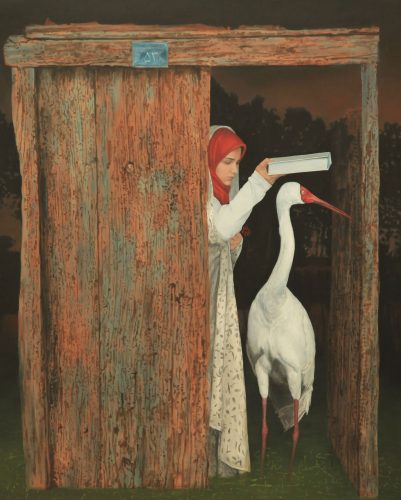
About a 100 years ago in Mazandaran Province in Iran, a young girl named Mina and a Persian leopard became friends. When Mina was older, a jealous villager in love with her shot and killed the leopard.
This much of the story is true, says artist Naeemeh Naeemaei in the opening statement to her exhibit running through Dec. 29 at the Jordan Schnitzer Museum of Art. The rest of the story is the stuff of legend because no one knows for sure what happened to Mina.
Naeemaei’s paternal family is from a nearby village in Iran. The story is close to her cultural roots, and she relates to the girl who befriended an animal. The subjects in her large oil and acrylic paintings are mostly women identifying with, protecting or grieving after animals.
She ties herself physically to salamanders, through strands of hair and fabric, in her self-portrait “Lorestan Mountain Newt” (2011). In “Persian Sturgeon” (2011), she pictures herself with a sturgeon, both of them about to be caught by a fisherman’s net.
“Siberian Crane” (2011) is a reference to a cultural tradition of blessing someone before they leave on a journey. The Siberian crane is an endangered species threatened by the loss of its environment. In this painting the artist holds a Koran over the bird’s head the way you would over a human, to ensure it will come back safely from its journey to Russia.
Three of the paintings in this exhibit relate to Mina’s story, but Naeemaei says when she paints she has in mind “every living creature whose species has been alive for thousands or millions of years and now is suffering from our behavior toward nature.”
She plans to have 15 paintings altogether about Mina in the series she calls Under the Earth, Over the Moon. The other paintings in this show are from “Dreams before Extinction,” a collection that was published in a book by the same title in 2013.
The Eugene exhibit is Naeemaie’s first in the United States. All the work is executed in a realistic style, but much of the imagery is surreal. Humans and animals are placed together in unreal scenarios. In “The Moon Falls a Thousand Times” (2019), moons in their different phases stick out of a muddy stream like so many stones. Mina walks away from the viewer heading downstream, her head obstructed by a leopard she carries on her shoulders.
Each painting is accompanied by a paragraph relating to subject matter. The artist doesn’t explain in this case about the many moons in the stream or how they’ve fallen. She focuses on ecological concerns. The Persian leopard, she tells us, has in real life decreased enormously.
One of my favorite paintings is “And in the Spring the Poppies Grew from his Blood” (2019). As you can tell from the title, it’s about grief and the possibility of revival. But it’s one of the physically lighter works, visually striking in its contrasting depiction of snow and the underworld.
Naeemaei’s paintings may remind you of certain modern masters, such as surrealist Belgian artist Rene Magritte or Mexican artist Frida Kahlo. They did me. But the subject matter — the concern for species and the damage we are doing to the environment — belong to this moment in time.
When climate change science is ignored by leaders who might take steps to address it, we look elsewhere for reality. We look to artists like Naeemaei, whose pictures of fantastic situations remind us of the urgent truth.